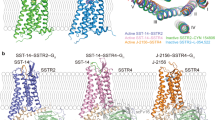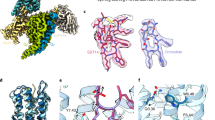Summary
In order to elucidate the amino acid residues that are involved in binding of somatostatin-14 (SST-14), mutations were introduced into the cDNA encoding somatostatin receptor subtype 3 (SSTR 3) using a polymerase chain reaction(PCR-)based approach. A glutamate residue (E92) in the transmembrane domain II of the SSTR3 sequence was subsequently mutated into a valine residue (E92V) referred to the sequence of SSTR5, which is known to preferentially bind SST-28. The mutation showed no significant differences in agonist binding, but caused enhancement of the sodium sensitivity of the receptor-agonist interaction.
Access this chapter
Tax calculation will be finalised at checkout
Purchases are for personal use only
Preview
Unable to display preview. Download preview PDF.
Similar content being viewed by others
References
Ausubel, F.M., Brent, R., Kingston, R.E., Moore, D.D., Smith, J.A., Seidman, J.G. and Struhl, K. (1987) Introduction of DNA into mammalian cells. In: Current Protocolls in Molecular Biology, Greene Pub. Ass., Brooklyn, N.Y., USA, Chapter 9, 9.0.1–9. 5. 6.
Epelbaum, J. (1986) Somatostatin in the central nervous system: physiology and pathological modifications. Prog. Neurobiol. 27: 63–100.
Higuchi, R., Krummel, B. and Saiki, R.K. (1988) A general method of in vitro preparation and specific mutagenesis of DNA fragments: study of protein and DNA interactions. Nucleic. Acids Res. 16: 7351–7367.
Hoyer, D., Luebbert, H. and Bruns, C. (1994) Molecular pharmacology of somatostatin receptors. Nauyn-Schmiedeberg’s Arch. Pharmacol 350: 441–453.
Kong, H., Raynor, K., Yasuda, K., Bell, G.I. and Reisine, T. (1993) Mutation of an aspartate at residue 89 in somatostatin receptor subtype 2 prevents Na’ regulation of agonist binding but does not alter receptor-G protein association. Mol. Pharmacol. 44: 380–384.
Meyerhof, W., Wulfsen, I., Schoenrock, C., Fehr, S. and Richter, D. (1992) Molecular cloning of a somatostatin-28 receptor and comparison of its expression pattern with that of a somatostatin-14 receptor in rat brain. Proc. NatL Acad Sci. USA 89: 10267–10271.
Nehring, R.B., Meyerhof, W. and Richter D. (1995) Aspartic acid residue 124 in the third transmembrane domain of the somatostatin receptor subtype 3 is essential for somatostain-14 binding. DNA Cell BioL 14: 939–944.
O’Carroll, A.-M., Lolait, S.J., König, M. and Mahan, L.C. (1992) Molecular cloning and expression of a pituitary somatostatin receptor with preferential affinity for somatostatin-28. Mol. Pharmacol. 42: 939–946.
Probst, W.C., Snyder, L.A., Schuster, D.I., Brosius, J. and Sealfon, S.C. (1992) Sequence alignment of the Gprotein coupled receptor superfamily DNA Cell BioL 11: 1–20.
Reichlin, S. (1983a) Somatostatin (first part). N. Engl. J. Med. 309: 1495–1505.
Reichlin, S. (1983b) Somatostatin (second part). N. Engl. J. Med. 309: 1556–1563.
Author information
Authors and Affiliations
Editor information
Editors and Affiliations
Rights and permissions
Copyright information
© 1996 Birkhäuser Verlag Basel/Switzerland
About this chapter
Cite this chapter
Nehring, R.B., Meyerhof, W., Richter, D. (1996). Reduction of somatostatin-14 binding to the rat somatostatin receptor subtype 3 by Na+ is enhanced by mutation of the glutamate residue 92 in the transmembrane domain II. In: Krisch, B., Mentlein, R. (eds) The Peptidergic Neuron. Advances in Life Sciences. Birkhäuser Basel. https://doi.org/10.1007/978-3-0348-9010-6_14
Download citation
DOI: https://doi.org/10.1007/978-3-0348-9010-6_14
Publisher Name: Birkhäuser Basel
Print ISBN: 978-3-0348-9866-9
Online ISBN: 978-3-0348-9010-6
eBook Packages: Springer Book Archive




